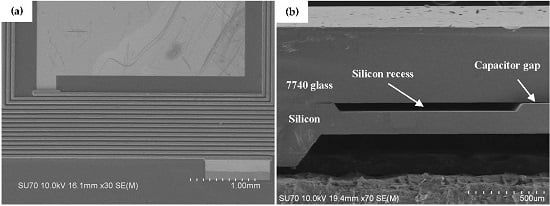Design and Manufacturing of a Passive Pressure Sensor Based on LC Resonance
Abstract
:1. Introduction
2. The Sensor Structure
3. Measurement Principles
4. The Simulation of the Pressure Diaphragm
5. The Manufacturing Process
6. Test Results and Discussion
7. Conclusions
Acknowledgments
Author Contributions
Conflicts of Interest
References
- Collins, C.C. Miniature passive pressure transensor for implanting in the eye. Biomed. Eng. IEEE Trans. 1967, 14, 74–83. [Google Scholar] [CrossRef]
- Fonseca, M.; English, J.M.; von Arx, M.; Allen, M.G. Wireless micromachined ceramic pressure sensor for high-temperature applications. Microelectromech. Syst. J. 2002, 11, 337–343. [Google Scholar] [CrossRef]
- Tan, Q.; Kang, H.; Xiong, J.; Qin, L.; Zhang, W.; Li, C.; Ding, L.; Zhang, X.; Yang, M. A wireless passive pressure microsensor fabricated in HTCC MEMS technology for harsh environments. Sensors 2013, 13, 9896–9908. [Google Scholar] [CrossRef] [PubMed]
- Akar, O.; Akin, T.; Najafi, K. A wireless batch sealed absolute capacitive pressure sensor. Sens. Actuators A Phys. 2001, 95, 29–38. [Google Scholar] [CrossRef]
- Chitnis, G.; Maleki, T.; Samuels, B.; Cantor, L.B.; Ziaie, B. A minimally invasive implantable wireless pressure sensor for continuous IOP monitoring. Biomed. Eng. IEEE Trans. 2013, 60, 250–256. [Google Scholar] [CrossRef] [PubMed]
- Baldi, A.; Choi, W.; Ziaie, B. A self-resonant frequency-modulated micromachined passive pressure transensor. Sens. J. IEEE 2003, 3, 728–733. [Google Scholar] [CrossRef]
- Fonseca, M.A.; Allen, M.G.; Kroh, J.; White, J. Flexible wireless passive pressure sensors for biomedical applications. In Proceedings of the Technical Digest Solid-State Sensor, Actuator, and Microsystems Workshop (Hilton Head 2006), Hilton Head Island, SC, USA, 4–8 June 2006; pp. 37–42.
- Cong, P.; Ko, W.H.; Young, D.J. Wireless less-invasive blood pressure sensing microsystem for small laboratory animal in vivo real-time monitoring. In Proceedings of the 5th International Conference on Networked Sensing Systems, INSS 2008, Kanazawa, Japan, 17–19 June 2008; pp. 80–86.
- Xue, N.; Chang, S.P.; Lee, J.B. A SU-8-based microfabricated implantable inductively coupled passive RF wireless intraocular pressure sensor. Microelectromech. Syst. J. 2012, 21, 1338–1346. [Google Scholar] [CrossRef]
- Luo, T.; Tan, Q.; Ding, L.; Wei, T.; Li, C.; Xue, C.; Xiong, J. A passive pressure sensor fabricated by post-fire metallization on zirconia ceramic for high-temperature applications. Micromachines 2014, 5, 814–824. [Google Scholar] [CrossRef]
- Jiang, H.; Lan, D.; Shahnasser, H.; Roy, S. Sensitivity analysis of an implantable LC-based passive sensor. In Proceedings of the 2010 3rd International Conference on Biomedical Engineering and Informatics (BMEI), Yantai, China, 16–18 October 2010; Volume 4, pp. 1586–1590.
- Shah, N.; Etemadi, M.; Kant, R.; Goldman, K.; Roy, S. Quality Factor Optimization of Inductive Antennas for Implantable Pressure Sensors. Sens. J. IEEE 2014, 14, 2452–2460. [Google Scholar] [CrossRef]
- Nopper, R.; Has, R.; Reindl, L. A wireless sensor readout system—Circuit concept, simulation, and accuracy. Instrum. Meas. IEEE Trans. 2011, 60, 2976–2983. [Google Scholar] [CrossRef]
- Iliescu, C.; Tan, K.L.; Tay, F.E.H.; Miao, J. Deep wet and dry etching of Pyrex glass: A review. In Proceedings of the ICMAT (Symposium F), Singapore, Singapore, 3–8 July 2005; pp. 75–78.
- Yue, C.P.; Wong, S.S. Physical modeling of spiral inductors on silicon. Electron Devices IEEE Trans. 2000, 47, 560–568. [Google Scholar] [CrossRef]
- Mohan, S.S.; del Mar Hershenson, M.; Boyd, S.P.; Lee, T.H. Simple accurate expressions for planar spiral inductances. Solid-State Circuits IEEE J. 1999, 34, 1419–1424. [Google Scholar] [CrossRef]
- Dentinger, P.M.; Clift, W.M.; Goods, S.H. Removal of SU-8 photoresist for thick film applications. Microelectron. Eng. 2002, 61, 993–1000. [Google Scholar] [CrossRef]
- Rasmussen, K.H.; Keller, S.S.; Jensen, F.; Jorgensen, A.M.; Hansen, O. SU-8 etching in inductively coupled oxygen plasma. Microelectron. Eng. 2013, 112, 35–40. [Google Scholar] [CrossRef] [Green Version]








| Size Features | Value |
|---|---|
| Inner diameter of the inductor coil | 3814 μm |
| Width of coil lines | 30 μm |
| Spacing between coil lines | 40 μm |
| Depth of inductor | 27 μm |
| Number of inductor coil | 14 |
© 2016 by the authors. Licensee MDPI, Basel, Switzerland. This article is an open access article distributed under the terms and conditions of the Creative Commons Attribution (CC-BY) license ( http://creativecommons.org/licenses/by/4.0/).
Share and Cite
Zheng, C.; Li, W.; Li, A.-L.; Zhan, Z.; Wang, L.-Y.; Sun, D.-H. Design and Manufacturing of a Passive Pressure Sensor Based on LC Resonance. Micromachines 2016, 7, 87. https://doi.org/10.3390/mi7050087
Zheng C, Li W, Li A-L, Zhan Z, Wang L-Y, Sun D-H. Design and Manufacturing of a Passive Pressure Sensor Based on LC Resonance. Micromachines. 2016; 7(5):87. https://doi.org/10.3390/mi7050087
Chicago/Turabian StyleZheng, Cheng, Wei Li, An-Lin Li, Zhan Zhan, Ling-Yun Wang, and Dao-Heng Sun. 2016. "Design and Manufacturing of a Passive Pressure Sensor Based on LC Resonance" Micromachines 7, no. 5: 87. https://doi.org/10.3390/mi7050087






